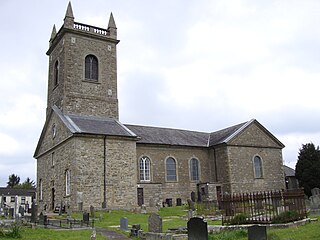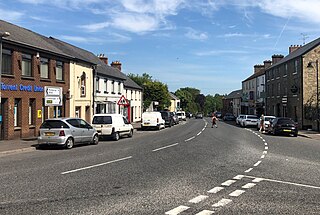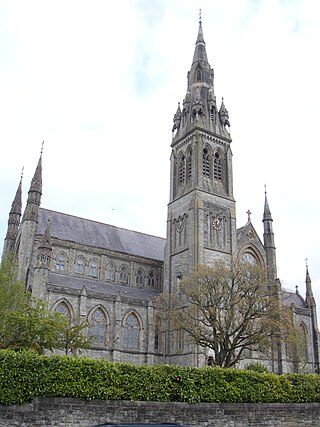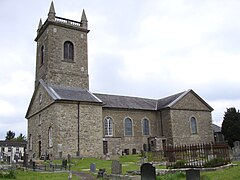
County Fermanagh is one of the thirty-two counties of Ireland, one of the nine counties of Ulster and one of six counties of Northern Ireland

County Tyrone is one of the six counties of Northern Ireland, one of the nine counties of Ulster and one of the thirty-two traditional counties of Ireland. It is no longer used as an administrative division for local government but retains a strong identity in popular culture.

Omagh is the county town of County Tyrone, Northern Ireland. It is situated where the rivers Drumragh and Camowen meet to form the Strule. Northern Ireland's capital city, Belfast, is 68 miles (109.5 km) to the east of Omagh, and Derry is 34 miles (55 km) to the north.

Castlederg is a town in County Tyrone, Northern Ireland. It lies on the River Derg and is near the border with County Donegal, Ireland. It stands in the townlands of Castlesessagh and Churchtown, in the historic barony of Omagh West and the civil parish of Urney. The village has a ruined castle and two ancient tombs known as the Druid's Altar and Todd's Den. It had a population of 2,980 people at the 2021 Census.

Fivemiletown is a village and townland in County Tyrone, Northern Ireland. It is 16 miles (26 km) east of Enniskillen and 26 miles (43 km) west-south-west of Dungannon, on the A4 Enniskillen-to-Dungannon road.

The Bishop of Clogher is an episcopal title which takes its name after the village of Clogher in County Tyrone, Northern Ireland. Following the Reformation, there are now parallel apostolic successions: one of the Church of Ireland and the other of the Roman Catholic Church.

Fintona, is a village and townland in County Tyrone, Northern Ireland. Its population at the 2011 Census was 1,164.

Aughnacloy, sometimes spelt Auchnacloy, is a village in County Tyrone, Northern Ireland. Close to the border with County Monaghan in the Republic of Ireland, the village is about 20 km southwest of Dungannon, and 7 km southeast of Ballygawley. It is situated in the historic barony of Dungannon Lower and the civil parish of Carnteel. In the 2011 Census it had a population of 1,045.

Ballygawley or Ballygawly is a small town in County Tyrone, Northern Ireland. It is about 20 kilometres southwest of Dungannon, near the meeting of the A5 Derry–Dublin and A4 Dungannon–Enniskillen roads.

Donaghmore is a village, townland and civil parish in County Tyrone, Northern Ireland, about five kilometres (3 mi) north-west of Dungannon. In the 2011 Census it had a population of 1,122 people. The village is beside the River Torrent, formerly known as the Torrent Flow.
Cermand Cestach was the name of a gold-covered pagan cult image which stood in Clogher Cathedral, County Tyrone, Ireland until the Middle Ages. Alternative spellings are "Cermand Celstach", "Cermaed Celsetacht", "Kermand Kelstach", "Kerman Kelstach" and the Giant Ermand Kelstach.

Augher is a small village in south County Tyrone, Northern Ireland. It lies just 6 miles to the border with County Monaghan and is 16 miles south of Dungannon. It is situated in the historic barony of Clogher and the civil parish of Clogher. The 2001 Census recorded a population of 399. The town gives its name to the local Gaelic Football Club.

Caledon is a small village and townland in County Tyrone, Northern Ireland. It is in the Clogher Valley on the banks of the River Blackwater, 10 km from Armagh. It lies in the southeast of Tyrone and near the borders of County Armagh and County Monaghan. It is situated in the historic barony of Dungannon Lower and the civil parish of Aghaloo. In the 2001 Census it had a population of 387 people. It is a designated conservation area. It was historically known as Kinnaird.

Desertmartin is a small village in County Londonderry, Northern Ireland. It is four miles from Magherafelt, at the foot of Slieve Gallion. In the 2001 Census the greater Desertmartin area had a population of 1,276. It lies within Desertmartin parish, Mid-Ulster District, and the historic barony of Loughinsholin. Neighbouring settlements include Draperstown, Magherafelt, Moneymore, and Tobermore.

Aghadrumsee is a small village in south-eastern County Fermanagh, Northern Ireland.

Saint Mac Cairthinn, also Macartan, McCartan, is recognized as the first presiding Bishop of Clogher from 454 to his death. One of the earliest Christian saints in Ireland, he is known as Saint Patrick's "Threin Fhir", or "Strong Man" for his dedication and faithfulness to the fledgling Church. His feast day is 24 March.

St. Macartan's College is a Roman Catholic boys' Diocesan College in Monaghan, Ireland. It is named after Saint Macartan, follower of St. Patrick and founder and bishop of the Diocese of Clogher. The school educates Catholic boys in County Monaghan and surrounding counties. It is located within the parish of Donagh. The school Feast Day is 24 March.

Trillick St Macartan's is a Gaelic Athletic Association club based in the parish of Trillick in western County Tyrone, Northern Ireland. It competes at Senior level in Tyrone GAA competitions. The club plays Gaelic football, ladies' Gaelic football and camogie.

St Macartan's Cathedral is the cathedral church of the Roman Catholic Diocese of Clogher in Ireland. It is located in the townland of Latlurcan, Monaghan town in the ecclesiastical parish of Monaghan and Rackwallace. It was built between the years of 1861 and 1893 and is the only Catholic cathedral in the county.
Saint Ciaran's College is a co-educational Roman Catholic secondary school located in Ballygawley, County Tyrone, Northern Ireland. It is within the Education Authority (Southern) area.



















